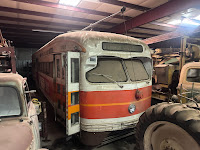Thanks to Gord McOuat, who passes along word - and photographic proof - that a pair of very historic, not to mention complete, interurban cars arrived today at Halton County Radial Railway. They were deaccessioned by Exporail, aka the Canadian Railway Museum, last December
as outlined here. To my knowledge, these are the first electric cars to depart CRM as part of that collection rationalization effort.
The first car, shown above and in the photos below taken a short time ago while it was being prepped at Exporail for shipment, is
Montreal & Southern Counties 104. This attractive interurban car is one of three ex-M&SC cars that I would classify as something of a "suburban" car, though it's still a big car - it's just not as big as the 600-series M&SC cars. Anyway, this car was built by Ottawa in 1912 along with
combine 107, which it joins at Halton County. These two cars both have HL control, so they will be able to run in MU. The third M&SC car of this general type in preservation,
car 9 at Branford, has K-control.
This will probably be car 104's last spin on a turntable for a very long time!
The second car, shown here and in the photos below, is
London & Port Stanley 10. Built by Jewett in 1915, it is one of four L&PS steel interurban cars preserved, and it joins two of the others -
car 4, which was a restaurant for decades, and
car 8, which is fully restored and operational - at Halton County. Though it may not be ready to "put the pan up and go," car 10 is complete and in far better condition than car 4. It looks like an excellent candidate for restoration, meaning Halton County likely has the opportunity to get a pair of two-car interurban trains out on their railroad in the coming years.
As shown below, both cars were loaded in the snow at Exporail during the past couple of days and made the trek to Rockwood. One point of trivia is that for both of these cars, Halton County is only their third owner. Both ran their entire service lives, well into the 1950s, for the same interurban line that ordered them, and both were owned by CRM since retirement.
Big 1910s interurban cars stand out from the crowd a bit at the gas station!
Gord mentioned that at least some of the other electric cars deaccessioned by Exporail have indeed found takers, so more information on that should be forthcoming. For now, it's great to see that cars 10 and 104 have found a good home at Halton County. The CRM collection is now down to 39 pieces on PNAERC, while the HCRR electric collection grows to 60.

















































